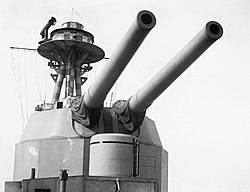BL 15 inch Mk I naval gun
| BL 15 inch Mark I | |
|---|---|

As mounted on monitor HMS Terror, 1915
|
|
| Type | Naval gun |
| Place of origin | United Kingdom |
| Service history | |
| In service | 1915-1959 |
| Used by | United Kingdom |
| Wars | World War I, World War II, Cold War |
| Production history | |
| Designed | 1912 |
| Manufacturer | see text |
| Produced | 1912-1918 |
| No. built | 186 |
| Specifications | |
| Weight | 100 long tons (100 t) |
| Length | 650.4 inches (16.52 m) |
|
|
|
| Shell | separate charges and shell |
| Shell weight | 1,938 pounds (879 kg) |
| Calibre | 15-inch (381.0 mm) |
| Recoil | 46 inches (1.2 m) |
| Rate of fire | 2 rounds per minute |
| Muzzle velocity | 2,458 feet per second (749 m/s) |
| Maximum firing range | 33,550 yards (30,680 m) (Mk XVIIB or Mk XXII streamlined shell @ 30°) HMS Vanguard - 37,870 yards (34,630 m) @ 30°, with supercharges. |
The BL 15 inch Mark I succeeded the 13.5-inch (340 mm) gun. It was the first British 15 inch (381 mm) gun design and the most widely used and longest lasting of any British designs, and arguably the most efficient heavy gun ever developed by the Royal Navy. It was deployed on capital ships from 1915 until 1959, and was a key Royal Navy gun in both World Wars.
This gun was an enlarged version of the successful BL 13.5 inch Mk V naval gun, specifically intended to arm the new Queen Elizabeth-class battleships as part of the British response to the new generation of Dreadnought battleships Germany was building during the naval arms race leading up to World War I. The normal slow and cautious prototype and testing stages of a new gun's development were bypassed, and it was ordered straight from the drawing board due to the urgency of the times. Despite its hurried development process, the gun met all expectations and was a competitive battleship main armament throughout both World Wars. According to an American report produced after World War II, the British 15 inch Mk I was the most reliable and accurate battleship main armament of the war, though other guns and mountings had superior individual features.
The barrel was 42 calibres long (i.e., 15 in x 42 = 630 in) and was referred to as "15 inch/42". This wire-wound gun fired a 1938 lb (879 kg) Mk XVIIB shell at a muzzle velocity of 2,458 ft/s (749 m/s).
The battlecruiser HMS Hood had its Mk I guns in a unique mounting, designated Mk II. Incorporating experience from the Battle of Jutland, the Mk II mounting had a maximum elevation of 30°, thus increasing the maximum range. In the 1930s a modification of the Mk I mounting, designated the Mk I (N), was introduced for use in those capital ships that were completely reconstructed. The Mk I (N) mounting also increased the maximum elevation from 20° to 30°. Maximum range in shipboard mountings was 33,550 yards (30,680 m) (30° elevation). During World War II older battleships with gun elevation limited to 20° were supplied with supercharges to increase their maximum range to 29,930 yards (27,370 m) at 2638 ft/s (804 m/s) using the Mk XVIIB or Mk XXII projectile, while HMS Vanguard could theoretically range to 37,870 yards (34,630 m) while using supercharges at a gun elevation of 30°. Coastal artillery mountings with higher elevations could reach 44,150 yards (40,370 m). The firing life of a 15 inch gun was approximately 335 full charge firings using standard charges, after which it had to be re-lined.
...
Wikipedia
